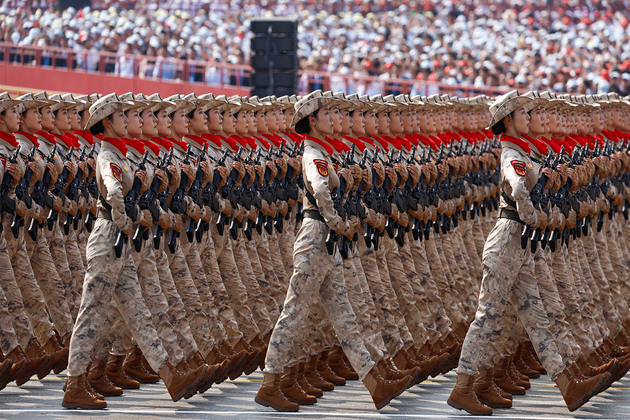2LT National News
Chinese military tops the charts
Nov 11, 2025
Hong Kong, November 10 (ANI): The People’s Liberation Army (PLA), the party-controlled armed force of China, has made tremendous progress in modernising itself in recent years. Much of this credit must be given to Chairman Xi Jinping, who has personally and relentlessly dragged the PLA up by its bootstraps.
Even just a couple of decades ago, the PLA was an outdated behemoth. It was oversized, operated quite antiquated equipment and was primarily designed to protect Chinese borders. Now, as the recent military parade on 3 September demonstrated, flush with modern weapons and a beneficiary of steadily increased defence budgets, the PLA is a force to be reckoned with not only by Asia but also by the USA.
Indeed, the USA regards China as its major pacing threat, and it has had to respond in kind to the PLA’s growing capabilities. The spectacular growth of the PLA has been tracked by the Center for Strategic & International Studies (CSIS) in the USA.
In a series of ten charts and relevant data points, the authors Matthew P Funaiole and Brian Hart recorded the progress made by the PLA in recent times. These ten points are informative, for they track the alarmingrise of Chinese military power.
The first piece of data relates to Chinese defense spending, which is in part a reflection of China’s growing prosperity and impact as an economic superpower. China’s official defense budget, according to Beijing, was nearly US$247 billion in 2025, up from some US$232 billion a year earlier. Spectacularly, Chinese spending on the PLA has multiplied phenomenally by a factor of 13 times in the past 30 years.
However, such listed figures from the Chinese government are very debatable, and the defense budget is most certainly higher than what is officially acknowledged. For example, the Stockholm International Peace Research Institute (SIPRI) estimated that China’s actual defense spending at about $318 billion in 2024 (compared to the official US$232 billion), while a study from the Texas National Security Review from the University of Texas placed it even higher at US$471 billion in 2023.
Secondly, the CSIS report highlighted China’s defense spending as a percentage of global military expenditure. Whilst it is true that China spends significantly less than the USA does, that differential gap is shrinking. Funaiole and Hart commented, ‘In 2012, China’s defense spending was one-sixth that of the United States; by 2024 that figure had risen to one-third.’
They added, ‘In the Indo-Pacific, China towers over its neighbours, spending five times as much on defense as Japan and nearly seven times as much as South Korea – two key US allies in the region.’ Of course, Chinese military spending vastly eclipses that of Taiwan too.
In fact, just the actual annual increase in China’s budget exceeds the entire defense budget of Taiwan. Taipei has no hope of trying to compete with the PLA in spending, so it must pursue an asymmetric strategy designed to deter a Chinese invasion by the threat of causing Beijing too much pain in money and blood.
A third metric that exemplifies the PLA’s development is the number of hulls in the PLA Navy (PLAN). Moving beyond a coastal force to a true blue-water navy able to project power, the PLAN now roves the world’s waterways.
In February, for instance, it alarmed Australia and New Zealand when a PLAN task group sailed south through the separating Tasman Sea and continued a circumnavigation of Australia.
Funaiole and Hart noted, ‘The PLA Navy surpassed the US Navy in number of battle force ships around 2014 and is projected to continue growing over the next decade. China still trails the United States in key metrics like overall ship tonnage, on-ship missile launchers and experience operating in far seas. Yet China is catching up in these areas.’
Presently, the PLAN has some 350 ships in its fleet, compared to less than 300 in the US Navy. Even as the American fleet stays static in terms of hull numbers out to 2030, China is projected to reach 435 vessels by the end of this decade, according to CSIS predictions.
Moving on to the fourth measure, the PLA is growing stronger in the air too. The CSIS stated: ‘Today, the PLA Air Force and Navy field a significantly larger fleet of combat aircraft than in years past. Most importantly, a growing share of those aircraft are more technologically advanced.’
Indeed, China is now flying two different fifth-generation fighters – the J-20 and the J-35/J-35A. This is similar to the USA, which operates both the F-22A Raptor and F- 35 family. However, China has been flight testing new sixth-generation fighters too, showing how rapidly its aerospace industry is making advances. As new, modern fighters are inducted, this allows the PLA to retire older second- and third-generation types.
CSIS calculated that, in 2024, the PLA possessed 230 fifth-generation fighters, 1,100 4.5-generation fighters like the J-10, 541 fourth-generation fighters and just 40 third-generation and 289 second-generation aircraft.
Fifthly, the CSIS report mentioned the cross-strait power imbalance with Taiwan. The might of the PLA vastly overmatches that of Taiwan in practically every facet of military capability.
The authors commented: ‘Xi Jinping has ordered the military to be able to seize Taiwan by force by 2027, and Taiwan remains the PLA’s top priority. A large share of PLA assets – especially naval and air assets – are concentrated within its Eastern and Southern Theater Commands, which would be most directly involved in any conflict over Taiwan.’
Thus, 100% of PLAN amphibious assault ships, 88% of landing ships, 80% of corvettes, 73% of frigates, 71% of destroyers and 66% of conventional submarines are arrayed near Taiwan in the PLAN’s Eastern and Southern fleets.
Elsewhere, 60% of special mission aircraft, 60% of bombers and 42% of fighters are located within the Eastern and Southern Theater Commands. Remember that the PLA has five theater commands that encompass and protect the whole country.
Moving on to the sixth measurement of PLA capability, Funaiole and Hart highlighted China’s growing nuclear warhead stockpile.
They said, ‘The growth of China’s nuclear arsenal has become one of the most alarming developments for Washington and its allies. According to estimates, China’s nuclear stockpile reached 600 warheads in 2025, more than doubling since 2019. The Department of Defense forecasts that China will continue to expand its nuclear arsenal to reach some 1,500 warheads by 2035.’
As China’s nuclear arsenal is expected to triple in the next decade, this means the USA must contend with not just Russia as a nuclear superpower, but also China. Beijing’s predilection for nuclear warheads was on visible display in September’s parade through Tiananmen Square, where the PLA Rocket Force (PLARF) showed new road-mobile DF-61, silo-based DF-31BJ and silo-based, liquid-fueled DF-5C intercontinental ballistic missiles. China also showed the JL-3 submarine-launched nuclear missile and the air-launched JL-1. The seventh metric highlighted by CSIS is China’s evolving missile arsenal. The PLA possesses the world’s largest arsenal of ground-based conventional and dual-use missiles. It pointed out, ‘The number of intermediate-range ballistic missiles has grown particularly quickly with the fielding of the DF-26 missile. It has an estimated range of up to 4,000 kilometers, putting distant US military bases in places like Guam within its reach and further complicating the security environment for US allies like Japan.’
In 2024, CSIS estimated China had 240 intermediate-range ballistic missiles (principally the DF-26). At the recent military parade in Beijing, the PLA Rocket Force also showed a DF-26D, although it is not immediately clear what the main advantages of this new variant are.
The eighth point showing the might of the PLA is China’s increasing use of satellites. ‘Militaries rely heavily on constellations of satellites to collect intelligence, enable communications, and provide targeting and navigation,’ Funaiole and Hart explained. ‘Xi has emphasised the importance of space for China, describing it as ‘an important strategic asset for the country’. As of 2024, China had hundreds of military and dual-use satellites in orbit, lofted there by its rapidly advancing space program.’
As of last year, China had 115 satellites dedicated to intelligence, surveillance and reconnaissance. Added to this were another 81 satellites for electronics or signals intelligence, 45 for navigation and 26 others.
Ninthly, the CSIS report mentioned shrinking ground forces. This might seem an odd factor to highlight, but it underscores how Xi has moved to streamline the PLA. Many soldiers moved to new formations such as technical, cyber and support forces. By cutting resources in one area, Xi could promote more effective gains in others. The ground force of 1.6 million in 2014 now amounts to around 960,000.
Finally, Funaiole and Hart listed the corruption problem. While some consider this a weakness of the PLA, it is important to recognise that Xi’s perennial battle to root out corruption reflects his desire to modernise the PLA and ready it for war.
After presenting all this information, the two authors acknowledge this: ‘How China would perform on the battlefield remains a major question. Having not fought a war in over four decades, the PLA is largely untested today. What is certain, however, is that China’s leaders are serious about improving the country’s military capabilities. The PLA has made rapid progress and is poised to continue to make major strides in the years to come.’ (ANI)



